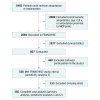Assessment of Tree-Based Statistical Learning to Estimate Optimal Personalized Treatment Decision Rules for Traumatic Finger Amputations
- PMID: 32083690
- PMCID: PMC7043191
- DOI: 10.1001/jamanetworkopen.2019.21626
Assessment of Tree-Based Statistical Learning to Estimate Optimal Personalized Treatment Decision Rules for Traumatic Finger Amputations
Abstract
Importance: Optimal treatment for traumatic finger amputation is unknown to date.
Objective: To use statistical learning methods to estimate evidence-based treatment assignment rules to enhance long-term functional and patient-reported outcomes in patients after traumatic amputation of fingers distal to the metacarpophalangeal joint.
Design, setting, and participants: This decision analytical model used data from a retrospective cohort study of 338 consenting adult patients who underwent revision amputation or replantation at 19 centers in the United States and Asia from August 1, 2016, to April 12, 2018. Of those, data on 185 patients were included in the primary analysis.
Exposures: Treatment with revision amputation or replantation.
Main outcomes and measures: Outcome measures were hand strength, dexterity, hand-related quality of life, and pain. A tree-based statistical learning method was used to derive clinical decision rules for treatment of traumatic finger amputation.
Results: Among 185 study participants (mean [SD] age, 45 [16] years; 156 [84%] male), the median number of fingers amputated per patient was 1 (range, 1-5); 115 amputations (62%) were distal to the proximal interphalangeal joint, and 110 (60%) affected the nondominant hand. On the basis of the tree-based statistical learning estimates, to maximize hand dexterity or to minimize patient-reported pain, replantation was found to be the best strategy. To maximize hand strength, revision amputation was the best strategy for patients with a single-finger amputation but replantation was preferred for all other injury patterns. To maximize patient-reported quality of life, revision amputation was the best approach for patients with dominant hand injuries, and replantation was the best strategy for patients with nondominant hand injuries.
Conclusions and relevance: The findings suggest that the approach to treating traumatic finger amputations varies based on the patient's injury characteristics and functional needs.
Conflict of interest statement
Figures


Comment in
-
Personalized Treatment for Finger Amputations-What Should We Do With the Thumb?JAMA Netw Open. 2020 Feb 5;3(2):e1921689. doi: 10.1001/jamanetworkopen.2019.21689. JAMA Netw Open. 2020. PMID: 32083683 No abstract available.
Similar articles
-
Patient-Reported and Functional Outcomes After Revision Amputation and Replantation of Digit Amputations: The FRANCHISE Multicenter International Retrospective Cohort Study.JAMA Surg. 2019 Jul 1;154(7):637-646. doi: 10.1001/jamasurg.2019.0418. JAMA Surg. 2019. PMID: 30994871 Free PMC article.
-
Cost-effectiveness of Finger Replantation Compared With Revision Amputation.JAMA Netw Open. 2019 Dec 2;2(12):e1916509. doi: 10.1001/jamanetworkopen.2019.16509. JAMA Netw Open. 2019. PMID: 31790567 Free PMC article.
-
Contribution of revision amputation vs replantation for certain digits to functional outcomes after traumatic digit amputations: A comparative study based on multicenter prospective cohort.Int J Surg. 2021 Dec;96:106164. doi: 10.1016/j.ijsu.2021.106164. Epub 2021 Nov 10. Int J Surg. 2021. PMID: 34774728
-
Efficiency in Digital and Hand Replantation.Clin Plast Surg. 2019 Jul;46(3):359-370. doi: 10.1016/j.cps.2019.03.002. Epub 2019 Apr 16. Clin Plast Surg. 2019. PMID: 31103081 Free PMC article. Review.
-
Controversies in the treatment of fingertip amputations. Conservative versus surgical reconstruction.Clin Orthop Relat Res. 1998 Aug;(353):63-73. doi: 10.1097/00003086-199808000-00008. Clin Orthop Relat Res. 1998. PMID: 9728160 Review.
Cited by
-
Outcome Measures Used to Assess Hand Activity in Amputee and Intact Populations: a Literature Review.Can Prosthet Orthot J. 2022 Dec 25;5(2):39023. doi: 10.33137/cpoj.v5i2.39023. eCollection 2022. Can Prosthet Orthot J. 2022. PMID: 37614636 Free PMC article. Review.
-
Individualized Mechanical power-based ventilation strategy for acute respiratory failure formalized by finite mixture modeling and dynamic treatment regimen.EClinicalMedicine. 2021 May 24;36:100898. doi: 10.1016/j.eclinm.2021.100898. eCollection 2021 Jun. EClinicalMedicine. 2021. PMID: 34041461 Free PMC article.
-
Digital Infrared Thermographic Imaging for Limb Salvage in Patients at Risk of Amputation: Prospective Observational Study.JMIR Form Res. 2025 Jul 21;9:e69072. doi: 10.2196/69072. JMIR Form Res. 2025. PMID: 40690661 Free PMC article.
References
Publication types
MeSH terms
LinkOut - more resources
Full Text Sources
Medical
Miscellaneous

